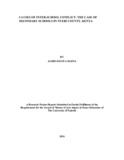| dc.description.abstract | Inter school conflicts have been an issue in the past years. Conflicts between students,
teachers and school administration, not once or twice but many times have got so violent that
some students are injured. This rivalry is caused by many reasons including academic
competition, competition in sports, or competition for attention from their sister schools.
Unfortunately, this level of conflict is not only witnessed in boys’ schools but also in girls’
schools as well. Over the past few years, we have witnessed a high level of rivalry between
schools, whereby most of this always turns out into violence. This study sought to establish
the factors that influence conflict among schools. This study which focused on secondary
schools in Nyeri County was informed by the following objectives; To investigate how
student indiscipline influence inter-school conflict; To determine the types of conflicts that
exist among schools; To determine how academic competition influences inter-school
conflict and how teacher incitement influences inter-school conflict; To establish conflict
resolution mechanisms that should be employed to curb inter school conflict. Following
Galtung’s theories, the study demonstrated the need to curb conflict to improve academic
performance. A sample of five (5) Principals, 40 teachers, 300 students and 10 subordinate
staff, was drawn from the target population from Nyeri County. Data was drawn from both
primary and secondary sources. Field research was carried out in Nyeri County by use of indepth
interviews. The study relied on both qualitative and quantitative methods of data
analysis. Study established that students’ indiscipline is a major cause of inter-school conflict.
The Data was synthesized and reported thematically. From the data collected the study found
that 50% of the Principals agreed that indeed they had experienced conflict between their
school and another school. This was echoed by 58% of the teachers who agreed that they
had experienced conflict between their school and another school. 43% of the students also
agreed that they had experienced conflict between their school and another school; however,
a majority 67% of the subordinate staff said they had never experienced conflict between
their school and another school, compared to 33% of the subordinate staff who agreed that
they had experienced conflict. From the findings, the study established that students’
individual indiscipline was a major cause to inter school conflict; drug abuse and disrespect
are among the main indiscipline related factors that influence interschool conflict. The study
findings indicated that academic competition was one of the factors leading to interschool
conflict. It also established that each school is fighting for the top position and this pressure is
usually mounted on the students, hence the students learn to treat their neighbours as
enemies. The study findings indicated that although teachers are not directly involved in
interschool conflict, they play a minor role in influencing interschool conflict. Teachers not
taking action whenever a case of misconduct by their students is reported to them eludes the
sense of prevention is better than cure since solving this might prevent it from escalating into
conflict. The study findings indicated that although teachers are not directly involved in
interschool conflict, they play a minor role in influencing interschool conflict. Teachers not
taking action whenever a case of misconduct by their students is reported to them eludes the
sense of prevention is better than cure since solving this might prevent it from escalating into
conflict. Recommendations were drawn from the interpretation of data collected and the
information gathered is deemed useful to Ministry of Education Science and Technology
(MoEST), the County Governments (CG), the School Administration and Boards of
Management (BOM) | en_US |



